Andrew J. Peters's Blog, page 9
October 11, 2016
A reflection on National Coming Out Day
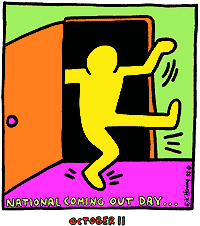
October 11th, 2016. It’s National Coming Out Day (NCOD), and here’s a little history. According to the Human Rights Campaign, NCOD was first celebrated in 1988 on the anniversary of the 1987 March on Washington for Lesbian and Gay Rights. Gay-affirmative psychologist Rob Eichberg and activist leader Jean O’Leary are credited with creating NCOD, and Keith Haring donated his artwork (above) as the logo. The purpose is for LGBTs to share their stories and thereby raise awareness and visibility.
I was not dancing out of the closet in 1988. I was a college freshman and only slightly aware that my stubborn, unrealized attraction to guys, which I was trying to suppress, meant that I was gay. I had had crushes on guys going back to elementary school, though I wouldn’t have described them as such at the time. In some ways I didn’t have the reference points to understand what I was going through. People in my world rarely talked about the possibility of boys liking boys, and when they did, they talked about it in a way that scared the hell out of me.
In high school, I became more aware of the existence of gay people, though mostly as an abstraction. I saw frightening images of gay men dying of AIDS in the media, and that was happening in big cities like New York and San Francisco as far as the national news was concerned. I was in suburban, upstate New York. No one declared that he was gay in my high school, and the few guys who fit the stereotype were the butt of jokes and shoved around the hallways at school. I was never a bully, but I laughed along at fag jokes and distanced myself from anyone rumored to be gay.
If that was what being gay was, I did not want to be that. I made a pact with myself that I would not be that, never, ever, no matter what I had to do.
I’ve come to understand that’s a bargain a lot of LGBT people make. Though, funny, as determined as I was mentally to not come out, my body and I might say some better sense I didn’t even know I possessed was more powerful. It was sort of like a spiritual experience, or as close to that as I can imagine, being an atheist. I do believe that something truer than I was, something stronger than I could consciously be, led me out of the closet and probably saved my life.
That’s certainly not to say it was all joyous and affirming at first. My journey out of the closet began with a crushing sense of loneliness and panic attacks that strangely didn’t seem to have any particular trigger. I’d feel like I was having a heart attack in the middle of class, and sometimes that chest-constricted, dizzy, breathless feeling just happened when I was alone in bed at night. I went to doctors, and medical tests showed there was nothing wrong with me, even though clearly this wasn’t normal. My body was rebelling against me, and in retrospect, I came to understand that it was demanding that I deal with part of my nature I was trying to banish.
I picked out a psychologist from a referral book at the college counseling center, quietly drawn to a group of words in her list of specializations: “male identity issues.” Deciding on a therapist based on that bit of info was not much more discerning than flipping through the book and landing on a page, but boy was I lucky. I think she understood what I was going through as soon as I walked through the door. Over a year of sometimes confrontational techniques, she helped me understand that my gayness was nothing to be ashamed of.
I remember leaving her office one day, and saying the words out loud: “I’m gay.” In that moment, the world was unveiled, and it was bright and colorful and full of possibilities, and I realized what it was like to walk down the street without my eyes pointed at the ground, and yes I felt incredibly free. Of course, it wasn’t always so easy coming out, but making that connection–that my loneliness and panic stemmed from suppressing my sexuality–it was like finally getting a diagnosis and a cure for a mysterious and debilitating disease.
As a side note, I should mention another thing that helped me tremendously was Rob Eichberg’s Coming Out: An Act of Love, which my psychologist recommended that I read.
I place myself among gay men in that in-between Gen X cohort, who came of age in the post-sexual revolution/AIDS-phobic 1980s and before the kinder new millenium with LGBTs on primetime, Gay-Straight Alliances in high schools, and marriage equality. Certainly there’s variation, but I think that many of us followed a trajectory of keeping our gayness hidden in high school and coming out when we were “out of the house,” whether going away to college or moving away from our families. It makes me happy to hear young people say: “I was never not out.” I’ve worked in private practice with older men who came out in their 50s, after marriages and raising kids.
Is one path harder or easier than the other? I don’t know. On one hand, coming out older brings to bear regret and often relationships to repair. On the other hand, coming out young sometimes puts kids in situations like bullying and rejection, which they’re not yet emotionally equipped to handle.
As I reflect on my coming out journey and those of younger people and older people I’ve known, a common thread is joy. That moment of knowing yourself, feeling free to be yourself, well, it may sound cliché, but it’s a gift that we get as LGBT people. And that’s worth celebrating for sure.
September 29, 2016
In honor of Banned Books Week

It’s that great time of the year when the American Library Association (ALA) celebrates the right to read without censorship. As an author and a reader of gay literature, I have a big stake in that. Books about LGBTs are particularly vulnerable to challenges by misguided factions of the public, particularly books for children and young adults.
I’ve never had any of my books challenged to my knowledge, though maybe that’s because my books could use a boost of discoverability (which is why you should ask your library to purchase eight or fifty of my titles for their collection). But if The Seventh Pleiade or Banished Sons of Poseidon was challenged because of homosexual content, they would be in prestigious company. Some of the most frequently challenged books for “homosexuality” include Stephen Chbosky’s Perks of Being a Wallflower and Alice Walker’s The Color Purple.
ALA’s list of the most frequently challenged books includes a lot of impressive titles, many of which have been staples in english literature classes from grade school to college. To join with public libraries in raising awareness, I thought I’d share some of my favorite “banned books.”
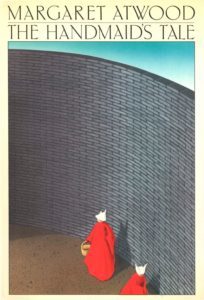
Banned for: sexual content and being offensive to Christians
I read Atwood’s feminist, dystopian sci fi novel during my cynical, anti-establishment college years, which, come to think of it, has stretched into my 40s. I loved that the story is in the high concept, dystopian vein of some of my other favorite futuristic books (Aldous Huxley’s Brave New World and George Orwell’s 1984, both of which have also encountered banning attempts) and gives that theme an underrepresented female perspective, which was certainly unusual in the 1980s.
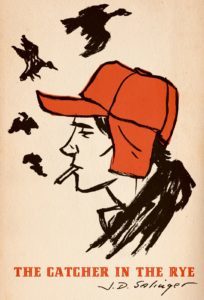 Banned for: excess vulgar language, sexual scenes, things concerning moral issues, excessive violence and anything dealing with the occult.
Banned for: excess vulgar language, sexual scenes, things concerning moral issues, excessive violence and anything dealing with the occult.
Scratch me hard enough, and, probably like many guys of my generation, I’d say J.D. Salinger’s Catcher in the Rye is my favorite book of all time. I think it’s the nostalgia. While the books was written for an earlier generation coming of age in the 1960s, Holden Caulfied spoke so well to sixteen-year-old me, disillusioned, scared, and wondering where the hell my place in the world was.
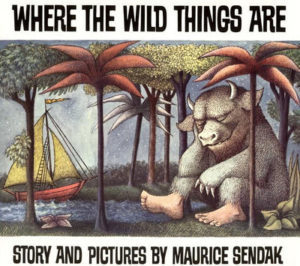
Banned for: witchcraft and supernatural elements
I always felt there was a little something subversive about Maurice Sendak’s children’s books, which was part of their appeal. I think that comes from Sendak’s point-of-view. Beneath the dreamlike wonder of his stories, there’s a minor melody of sadness and alienation, and I feel that speaks to a lot of kids.
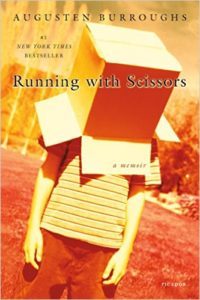
Banned for: explicit homosexual and heterosexual situations, profanity, underage drinking and smoking, extreme moral shortcomings, child molesters, graphic pedophile situations and total lack of negative consequences
Often compared to David Sedaris (whose books have also been challenged for high school classroom reading), Augusten Burroughs writes quirky memoirs that are a little bit edgier and I’d say more affecting (I love Sedaris as well). Both the book and the movie had me in tears.
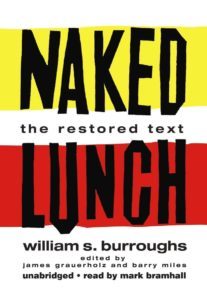
Banned for: drug use, sexually explicit acts, and obscene language
Given that parental warning, what teenager would not want to read William Burroughs’ graphic, counterculture book? Naked Lunch got passed around by my high school friends and blew open my world. Not that I’m recommending the book for early grade readers, but Burroughs’ psychodelic, polymorphously perverse rant against conformity was a wonderful affirmation of queerness that helped me better understand the world.
September 27, 2016
This latest Dispatch from Hogwarts G.S.A. (on tropes) is up at QSF
My monthly column “Dispatches from Hogwarts G.S.A.” is up at Queer Sci Fi. The topic this month: Tropes We’d Like to See.
“Every genre has them [tropes], and while the term has a negative connotation, we wouldn’t say that tropes are always an indication of bad storytelling. One measure of good storytelling is that it reveals to the reader something true about the world, which when you think about it, is impossibly subjective, thus one reader’s hackneyed trope is probably another reader’s warm and fuzzy truth.
We’d say a bad trope is one that reinforces stereotypes that are already problematic in real life, and minority characters like queer people are particularly vulnerable to them.”
The article goes on to suggest some tropes–partially tongue in cheek–that might freshen up the gay fantasy genre. You can check out the full article here.
September 21, 2016
Read an excerpt from The City of Seven Gods
Here’s an exclusive look between the covers of The City of Seven Gods.
Allright, it’s not exclusive if you consider that Amazon allows you to ‘look inside’ to view the first few pages. But you won’t get my scene set-up and image fandanglery over at Amazon. Here we go.
I chose a passage from early in the book, but it does need a word or two to orient you. The main character here is Kelemun, a nineteen-year-old priest of Aknon whose vows require that he reserve his body for the veneration of the god, with the insidious exception that young priests are trained to provide “blessings of the flesh” to the wealthiest of pilgrims.
Kelemun is being pursued by Praxtor, the son of Omani (a cherished title for Caliph), and Praxtor had just burst into the temple to try to free Kelemun, which was a sacrilege and a scandal. This passage is a flashback in which Kelemun admits he played a part in that disaster.
~
Praxtor was the most foolish of men. Kelemun should have recognized that the first time they had met. He should have foreseen the danger and steered himself around it. If he had been more careful, the situation would never have come to this.
It had started the past springtide, the month of Aknon’vell, which was the highest holy season for the priesthood. The rains of winter had passed, and it was the time, by Qabbat’s grace, for the earth to be reborn. The coryphei priests, who called the people to prayer, descended to the city to festoon the streets with fronds of the doam. Omani commissioned street fairs, chariot games, and many spectacles of music and dance in the city pavilions.
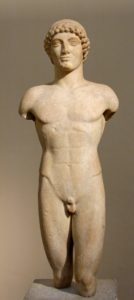
Ancient Greek kouros sculpture, a prototype for the kouros priest of Temple Aknon
But everyone looked forward the most to the Procession of the Kouri. It was the only time the sacred keepers of Aknon’s house ventured among the people. That year’s procession had engendered a great deal of hysteria since a new high priest, Aknon-Horheb, presided over the festival. He was said to have tall ambitions. The senior priests examined the boys to sort out flaws in posture, composition, and complexion. The sidelines of the parade boulevard would be filled to bursting with people vying to catch a glimpse of the handsome youths and to toss racemes of hyacinth at their feet. Only the most beautiful earned a foremost place in the procession. For Aknon-Horheb, a good showing foretold good profits at the Ward of Prayers.
Kelemun had devoted his body and soul to glorify the god, but he had not been without a warm glow of pride when Aknon-Horheb had announced that he would lead the body of kouri, a delegation of ten score of his peers. He had been named exemplar for the festival and would wear the sacred braided plait, woven to the back of his hair and fanning to his shoulders like a regal bonnet, the embodiment of Aknon, the Prince of Gods.
The day began with bearing blessings to Omani at his audience hall in the palace. Kelemun was to bestow the priesthood’s gifts to the throne. He stepped forward from the delegation of youths and walked to the royal estrade where Omani Neiron, sovereign lord of the city, was bedecked in a blued turban of the finest Qabbati dye. An egg-sized amethyst hung on his forehead, and he sat on his high-backed throne, which was ornamented with flashing orichalcum. His Wazirs, Grandees, and military captains sat behind him like fancy figurines.
Kelemun knelt before the throne and kissed the ground between his hands. He laid a wreath of sapling boughs that held a bounty of navel stones crafted from exquisite gypsum, azurite, and serpentine. Kelemun spoke the cherishing oath. Omani raised his right palm to say the gifts were acceptable to him.
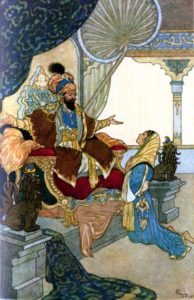
An illustration from The Arabian Nights, a source of inspiration for the royal court of Omani Neiron
That should have been all. Omani Neiron was a good diplomat to every one of his city’s cults, but he was not known to be partial to Aknon, nor the beauty of men. A young man rustled up from the carpeted estrade just as Kelemun stood to return to his place with the kouri.
“Halt there,” the man called.
This brought out a murmur of amusement from Omani’s court. A blush blazed across Kelemun‘s face for being the cause of it, and he prayed it did not show while he stood with his head bowed in submission. He had been taught the dignitary rites and manners and rehearsed them in front of the elder priests. But he was shamefully at a loss over how to handle this interruption of the ceremony. Had he done something improper?
Kelemun’s curiosity betrayed him, and he stole a glance at the young man drawing near. He wore the blued turban of royalty, and his face shone as radiant and arresting as the waxing moon. He had a trim moustache and beard and warm, sparkling, chestnut-colored eyes. A regal balm of magnolia oil surrounded him. Kelemun guessed the man was around the same age as himself, though in his long-sleeved, jeweled coat with a splendid sickle-sword holstered at his waist, he stood a staggering height above a kouros priest. Of course, the man was Praxtor though Kelemun knew very little about Omani’s family at the time.
Kelemun looked upon the man with exceeding wonder. He smiled, and Kelemun found himself responding with a grin. The great hall was silent. Praxtor called over a court attendant who bore an ornate chest fashioned from juniper wood. The chest contained tribute that was to be presented to Aknon-Horheb.
Praxtor bade the man to open the chest. A glittering trove of sapphire, emerald, and ruby doubluns swum in Kelemun’s vision. He glimpsed ornamental gifts as well. Praxtor selected one of them and returned his attention to Kelemun. He held a tulip forged from solid orichalcum. The graceful flowers were cultivated in the Pyrrhean countryside, far north of the River Goran valley, and they were prized the world over for their beauty. The gilded tulip seemed to hover in Kelemun’s sight. Such a beautiful thing could not possibly have been crafted by a mortal hand. It was meant for the gods themselves.
“What is your name?” Praxtor said.
“Kelemun, Your Grace.” By the god’s mercy, he remembered to bow from the waist and remain there.
Praxtor gestured for him to stand erect and show himself. “Kelemun,” Praxtor repeated. Every syllable from his lips fascinated Kelemun. Ensorcelled by their meeting, Kelemun felt as though the many people in the hall had disappeared.
 Praxtor held out the golden tulip. “For you, Kelemun. In tribute to the most handsome man in all of Qabbat’lee.” He turned to the court and raised his voice. “The most handsome man in all of the emperor’s lands.”
Praxtor held out the golden tulip. “For you, Kelemun. In tribute to the most handsome man in all of Qabbat’lee.” He turned to the court and raised his voice. “The most handsome man in all of the emperor’s lands.”
Kelemun reached to take the flower. What else was he to do? In the exchange, he brushed his knuckles against Praxtor’s for an instant. That was bold and scandalous, but Kelemun did not know himself at the time.
Praxtor spoke to him quietly, “I should like to see you again.”
Behind them, Aknon-Horheb cleared his throat and spoke, breaking the enchantment.
“Our Lord is grateful for your generosity.”
With that, Kelemun retreated to the body of kouri. The elder priests ushered the group from the hall.
September 17, 2016
The story behind the story

Map of The Known Lands, designed by myself and my husband Genaro Cruz
For The City of Gods release week, I thought I’d share the “story behind the story.”
So first, the story in front of the story is a turning point in two young men’s lives. Kelemun is a nineteen-year-old boy from the slums who, owing to his good looks, was bought from his parents at the age of twelve to be indoctrinated as a kouros priest in the Temple of Aknon. For Kelemun, it was grist to show his stern, disabled father he’s not a burden, and he works his way up to favored status in the priesthood. Young priests are chosen to exemplify the lord of beauty and propagation, and they tend the inner sactum of the god, which attracts pilgrims from around the world who pay fortunes to beseech Aknon for miracles.
As he has been taught, when a pilgrim wants more than to behold his golden likeness and pray with him, he provides. His body is a vessel of Aknon. But when a handsome prince of untold wealth fervently and chastely pursues him, Kelemun begins to question what he thought he knew about himself.
Ja’bar is a few years older and of a fantasy race called Stripelings, tall and broadly built with skin like molasses swirled with honey. He has known indentured servitude as well. He comes from a country where a crooked king made slaves of his own people to harvest fruit and lumber from his precious doam groves. Ja’bar broke out of the slave barracks when the emperor offered Stripelings freedom if they joined his army to overthrow the king.
After the war, having no kin to root him, Ja’bar came up north to learn about the world in the famous city of Qabbat’lee, and he was picked out from mobs of grunts to be a warden at the Temple of Aknon. Ja’bar’s not fond of working for folk who worship a god who commands that boys be used for profit, though in his experience, it’s best not to question the people who put bread in your hands. Guarding the temple is good, paying work for a Stripeling, a jungle savage in the eyes of the northerners, and a whole lot better than gambling his life on a bloodsport stage as many of his kind end up doing. He has a dream to buy a plot of river land and never have to trouble with anyone being his master. But when the high priest starts giving him jobs that are more and more ruthless, he wonders if he’ll be able to live with himself with a dream paid for by the misfortunes of others.
A chance encounter between Kelemun and Ja’bar leaves indelible impressions and the possibility of a better life for them both.
So how did I come up with this far-flung story? The first thing that interested me was exploring temple life in ancient times, and in a sense Kelemun was an expansion on the character of Dam, a young priest in The Seventh Pleiade and Banished Sons of Poseidon. The position of boys in the priesthood is fascinating to me. On one hand, it was an opportunity for learning, and room and board, in a feudal society where education and finer trades were not easy to come by.
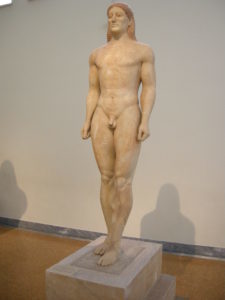
5th century B.C.E. Kouros statue at the Museum of Archeology in Athens, retrieved from Wikipedia Commons.
On the other hand, priests of the ancient world, particularly the underlings one must assume, were not regarded with our modern sense of deference. They were more like workers, providing crafts for their communities, and the Greek historian Herodotus wrote about the practice of temple prostitution from his travels around the ancient world.
It’s impossible to say how reliable his account was (the Greeks, like the Romans, were known for disparaging the “barbaric” practices of other civilizations in contrast to their more righteous society). But it gave me the idea for a religious cult that prospers through a combination of mysticism and sex trafficking.
One thing I took liberties with was the idea of the kouros, another source of inspiration for me. Kouros iconography was an ancient practice, probably influenced by early artwork of the Egyptians and proliferating throughout Greece before the classical age.

The kouros archetype lives on in images of the young male ideal such as this ad for a cologne from Yves Saint Laurent.
The kouros was associated with the handsome god Apollo, who may have been the “gayest” of the Greek gods based on his exploits with other men (Hyacinth, who he turned into a flower after his death; Cyparissus, who became the cypress tree after their ill-fated affair; and Iapyx, who Apollo gave the gift of healing, among others). I was curious about the possibilities for an ancient religious cult that worshipped a male god of beauty via priests who emulated his likeness. Thus Apollo became the more Egyptian “Aknon.”
Here’s part of a paean to Apollo by the 3rd c. B.C.E. poet Callimachus:
So, young men, prepare yourselves for singing and dancing.
Apollo appears not to all, only to the good.
He who sees him is great; who does not is lowly.
We will see you, Worker from Afar, and we will never be lowly.
Let the cithara not be silent.
Nor your step noiseless with Apollo approaching, you children,
If you intend to complete the marriage vows and to cut your hair,
And if the wall is to stand on its aging foundations.
Well done the youths; the strings are no longer at rest.
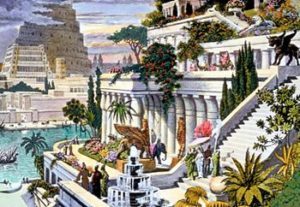
A 19th century rendition of the Hanging Gardens of Babylon, image retrieved from Wikipedia Commons
Another point of inspiration was the great cities of the ancient world like Babylon, Ur, and Akhetaten, which were wonders of technology and wonders of religious iconography. I created the fictional city of Qabbat’lee, named after Qabbat, a father god and god of the sun, and imagined it as a place of political and religious significance–the City of Seven Gods–as well as a cosmopolitan center. I wanted to depict realistically the kinds of conflict that might emerge in such a place between people of different races, the nobility and the priesthood, and the nobility and her masses of peasant subjects.
As I began to write the story, I was drawn to themes of disillusionment and awakening, which may be taken as a more modern sensibility, though I believe those universal aspects of humanity had to exist in ancient times as well, and not just for the leisure class philosophers. We don’t know much about how common men like priests or laborers really viewed their world, and I wanted to explore that through this story.
So there’s the scoop behind the scenes. Let me know what you think if you pick up the book!
September 13, 2016
RELEASE DAY! The City of Seven Gods
You may have noticed I’ve been quite busy here. I’ve been talking up the Kindle Exclusive release of Poseidon and Cleito from EDGE Science Fiction and Fantasy, and now I’m switching gears to let you know about another title, just released today at retailers worldwide by Bold Strokes Books.
 How about that? It’s a big month for me, and I’m doing my best to keep up with it!
How about that? It’s a big month for me, and I’m doing my best to keep up with it!
I wrote The City of Seven Gods as somewhat of an adult companion piece to The Seventh Pleiade and Banished Sons of Poseidon. The setting is similarly ancient world, though the sources of inspiration roamed a bit farther, and farther back in history, to Egypt, Mesopotamia, and Africa.
The story is also a departure from the Atlantis legend, which may come as a surprise (yes, I do write about other things besides Atlantis from time to time). I was inspired by the grandness and religiosity of the great cities of the ancient world like Ur and Babylon and Alexandria, and I wanted to expore what life may have been like during a time of nascent, cosmopolitan living, lavish religious iconography, and huge divisions between the rich and poor. The story follows two men of minor status finding their way through that world.
Here’s the back cover blurb:
Kelemun was bought from his peasant parents to tend the inner sanctum of the house of Aknon, where wealthy men pay mountain sapphires to behold the beautiful servants of the god. Chosen to bring offerings to Caliph, Kelemun captures the fascination of the young prince Praxtor who has never been denied anything his heart desires.
Ja’bar was hired to roughhouse wayward proselytes for the high priest Aknon-Horheb. In Qabbat’lee, it’s good paying work for a Stripeling, a jungle savage in the eyes of the city natives, and if he’s stingy and stays out of trouble, it will buy him a plot of river land.
But the splendor of Qabbat’lee is a mirage disguising a grotesquerie of corruption. When Kelemun and Ja’bar’s threads of fate entwine on a night of chilling betrayal, their only hope for redemption and survival may lie in one another.
The City of Seven Gods kicks off a new series called The Lost Histories, which will chronicle the lives of an ancient people in a world where men are bought and sold, religious cults vie for wealth and power, and civilizations clash. I’m presently tucking into the manuscript for Book 2. All this month look for giveaways and inside-the-story features here and at blogs like Queer Sci Fi and The Novel Approach. And, if you want to pick up the book right away, I posted the handy buy links below. When you buy at the publisher’s webstore, you can bundle your purchase for extra savings.
September 11, 2016
Some of my favorite ancient world historicals
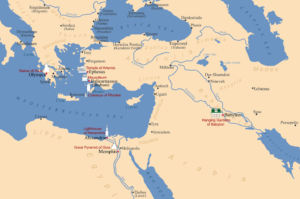
A map of the ‘Seven Wonders of the World’ per the ancient Greeks. Image retrieved from Wikipedia Commons
Not a big surprise here. I like to read ancient world historical fiction. Some folks recently asked me at my Facebook event: what kind of research did you do for Poseidon and Cleito? That gave me the idea of doing this short post to share some of the books that influenced my writing.
I re-read some of the classical mythology and literature that I had first enjoyed in high school and college: Edith Hamilton’s Mythology and Homer’s The Iliad and The Odyssey. I also read for the first time Plato’s Timaeus and Crtias dialogues, of course with special attention to the passages concerning the Atlantis story.
I took a pretty broad approach to non-fiction, or in some cases “non-fiction” on the subject of Atlantis: Lewis Spence’s The History of Atlantis and Frank Joseph’s The Destruction of Atlantis, among others, and I even plodded through Edgar Cayce’s Atlantis with his accounts of strange, psychic readings. I also read up on ancient Greek history, costume and daily life.
All of those sources helped with imagining the setting of the story, though I found that reading really good historical fiction probably helped even more.
Here’s a list of some of my very favorites in case you’re interested in the time period.
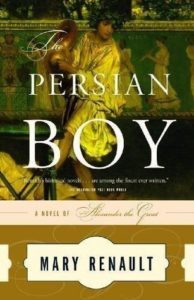 Mary Renault’s series on the history of Alexander the Great is absolutely fantastic. Probably because of its intriguing perspective, I enjoyed the most The Persian Boy, which is told from the point-of-view of Alexander’s eunuch attendant and lover Bagoas. The book certainly has strong romantic elements, but it’s not a romance novel in the modern sense. The story follows the tragic history of Bagoas, a boy who is castrated and bought and sold to various masters after his chieftain father is overthrown and murdered. He ends up in Alexander’s household, and the story chronicles the conquest of the Persian empire, Alexander’s ill-fated march into India, and the last days of his life in Babylon, all through the eyes of an unlikely and compelling storyteller.
Mary Renault’s series on the history of Alexander the Great is absolutely fantastic. Probably because of its intriguing perspective, I enjoyed the most The Persian Boy, which is told from the point-of-view of Alexander’s eunuch attendant and lover Bagoas. The book certainly has strong romantic elements, but it’s not a romance novel in the modern sense. The story follows the tragic history of Bagoas, a boy who is castrated and bought and sold to various masters after his chieftain father is overthrown and murdered. He ends up in Alexander’s household, and the story chronicles the conquest of the Persian empire, Alexander’s ill-fated march into India, and the last days of his life in Babylon, all through the eyes of an unlikely and compelling storyteller.
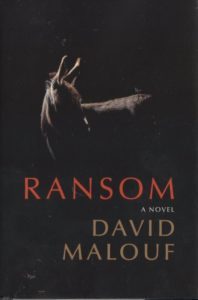
There are a good number of re-tellings of the Trojan War, but David Malouf’s quiet novel, focused on the days following Achilles’ murder of the Trojan Hector, stood out to me. Ransom is more about the humanity of Hector’s father King Priam, and ultimately Achilles himself, rather than scenes of battle and military strategizing. Malouf’s writing style is simple, evocative, and powerful. His choice of giving equal time to the less explored character of Priam also pulled me in.
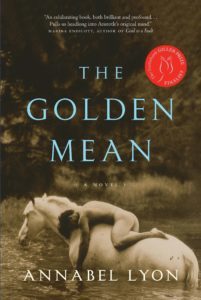 So by now you can tell I have a preference for character-driven, atmospheric stories over sword-clashing adventures. I do like action-adventures from time-to-time, but I really have to connect with the heroes to enjoy the story. If what drives them is simply “for the honor of home and country,” I just can’t work up much enthusiasm.
So by now you can tell I have a preference for character-driven, atmospheric stories over sword-clashing adventures. I do like action-adventures from time-to-time, but I really have to connect with the heroes to enjoy the story. If what drives them is simply “for the honor of home and country,” I just can’t work up much enthusiasm.
That’s why I loved Anabel Lyon’s The Golden Mean, which reimagines two complex characters from early Greek history: Aristotle and his young pupil Alexander. The portrayal of each man’s struggles close to home are expertly realized: for Aristotle, a nervous condition which modern medicine would likely call depression, for Alexander, a broken family domineered by his ruthless father. The “Golden Mean” here has to do with emotional moderation: the balance between despair and hope and the exercising of cruelty versus compassion.
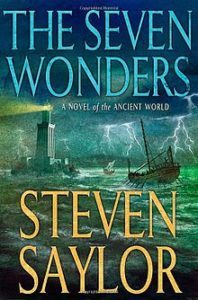 Over the years, I’ve been happy to discover a subset of ancient world books with mystery elements. I grew up reading mysteries, and in my 20s read a lot in the area of gay fiction. Ancient world + mystery is a winning formula for me. Ancient world + mystery + gay characters is even better, which is why I singled out Steven Saylor’s Roma Sub Rosa series and The Seven Wonders of the World.
Over the years, I’ve been happy to discover a subset of ancient world books with mystery elements. I grew up reading mysteries, and in my 20s read a lot in the area of gay fiction. Ancient world + mystery is a winning formula for me. Ancient world + mystery + gay characters is even better, which is why I singled out Steven Saylor’s Roma Sub Rosa series and The Seven Wonders of the World.
The story follows a young man’s (Gordianus) journey of a lifetime to visit each of the seven wonders with his tutor Antipater. At each site, there is some intrigue for Gordianus to uncover, and in Saylor’s style, a bit of camp and humor. I don’t mean to overstate the gay content. There’s just a touch of that, but I like that the world of Gordianus, the ‘finder’ or detective of the Roma Sub Rosa series, includes gay and bisexual characters.
Some other historical mysteries that I’ve liked are Gary Corby’s Athenian Mysteries series and Nick Drake’s Rahotep series set in Egypt.
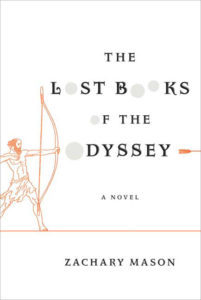 One last pick from me: I really enjoyed Zachary Mason’s ambitious “excavated” stories about Odysseus and some of the other heroes of the Trojan War. His writing style is gorgeously evocative of the time period, and what I also appreciated was the unexpected but believable twists to the well-known source material. For example, Odysseus, returning to Ithaca after ten years of adventures, finds Penelope remarried, and shrugs off that they have both moved on with their lives, which, for what I’ve come to understand about the world, feels like a more likely outcome than murdering his wife’s suitors and settling back into married life.
One last pick from me: I really enjoyed Zachary Mason’s ambitious “excavated” stories about Odysseus and some of the other heroes of the Trojan War. His writing style is gorgeously evocative of the time period, and what I also appreciated was the unexpected but believable twists to the well-known source material. For example, Odysseus, returning to Ithaca after ten years of adventures, finds Penelope remarried, and shrugs off that they have both moved on with their lives, which, for what I’ve come to understand about the world, feels like a more likely outcome than murdering his wife’s suitors and settling back into married life.
September 6, 2016
Turn on your Kindle Day and Facebook chat
Well, it’s all been leading up to this: Thursday, September 8th from 7:00 – 9:00 PM EST, EDGE Science Fiction and Fantasy is hosting a “Turn on Your Kindle” event, including a live chat with yours truly during which I’ll talk about the story behind Poseidon and Cleito and answer questions.
Here’s how you can participate…
Step One: RSVP to the event on Facebook.
Step Two: On Thursday, September 8th, purchase a digital copy of the book. It’s available at Amazon exclusively during this early release period, and can be purchased in formats for most readers (Kindle, iPad, iPhone, Kobo, etc.. sorry Nook readers, that’s coming in December). They’re offering the book at the rather affordable price of $2.99 for a limited time.
Step Three: Log into Facebook on Thursday between 7:00 and 9:00 PM and say hello! If you own a Kindle, you can download your copy at that time. That produces a nice bump on Amazon’s website, which boosts the visibility and discoverability of the title.
What can you expect at the chat? Anything and everything you want to know about the book, some fun mythology trivia, book extras (you want the authoritative answer to where Atlantis was located?), and plenty more. I’m really looking forward to it and hope to see you there!
September 1, 2016
#PoseidonWeek: Poseidon through the ages
Updated September 1st 9:00 PM: The #PoseidonWeek contest is closed, and the two winners, both from my Facebook page, selected by random.org are: Yendur Benny and Jutta Ervell! Thanks to everyone for stopping by. It was fun. 
August 31, 2016
Exclusively for #PoseidonWeek: An excerpt from the story
It’s always tough for me to decide on excerpts to use for readings or sharing on social media. I actually prefer to have someone decide for me, since I’m probably too close to the story to evaluate what would make for an entertaining snippet for people unacquainted with the story.
Here I chose a tried and true strategy: the opening scene from the book. It doesn’t require any set up, and my hope with the opening was to set a mystical tone for the narrative through this encounter with the main character Donnogen and a steppe Witch.
I included some images from my Pinterest inspiration board. I hope you enjoy it!
~
Chapter One
The Witch’s hovel stood on a bald hilltop covered with snow. It had been a half day’s journey for the young hunter to find it, minding his grandmother’s instructions from seasons past.
“Find the spitting cavern on the bank of the sea. Climb the bank to the margins of the ancient woods and follow the trodden path to a glassy plain. There she will be, perched over the barren land, like a shepherdess to a ghostly flock.”
The sun hung low on the horizon, and the snowy field was no longer glassy. The towering trees at the border of the woods cast a lake of shadow that stretched toward the hill, soon to devour it in darkness. An infinite quiet surrounded the hunter. For a delicate moment, fear bit at him, and he halted, suspended in a void of silence while the claw of frost clutched his breath. He pushed on through the field.
It was time for him to know his name.
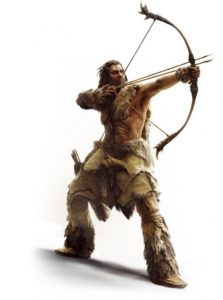
An illustration that I pinned from 3duegos.com, a prototype for the hunter Donnogen.
Climbing the hill was a trudge through frost-crusted dunes that buried him to the top of his deerskin leggings. There were no other tracks up the hill. Though it was deep into the season of freeze, the clouds had not shed their tears of snow for three suns.
The home was a wattle-roofed roundhouse that looked like a giant mushroom crowning its snowy mount. It was no more than a dozen strides across, and its cone cap was buckled and frayed from many seasons of freeze and thaw. Smoke rose up from its chimney, and the snow encircling the house had melted, forming a gutter. A gnarled stake of wood warded the entrance. A freshly-killed white fox had been impaled on the stake.
The hunter stopped at the threshold for a moment, remembering his amma. He shut his eyes and spoke silent words to reach his grandmother in the otherworld.
“My beard grows thick, Amma. I am a man, and I have come, as you told me. The clan taught me well. I can chase the spotted deer, clean its hide from its flesh, and make my own hatchets and spears. Watch over me. You are always in my heart.”
He pushed aside the heavy mats hanging in the doorway and stepped inside. The sudden heat was arresting, and the stench was choking. The Witch must have been boiling some kind of animal fat. Mammoth hides hung from the hut’s rafters, dividing the space into a puzzle of compartments. In good times, the mammoth hunter clans might have had one pelt they could afford to show off in such a way, and this woman had at least three that he could see! Good barter: men from all parts of the steppe must have traveled to her to ask for name-readings.
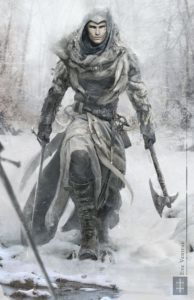
Pinned from artofmisc.tmblr.com, a prototype for the Sea People
That was trade from seasons past. There weren’t any clans of mammoth hunters left on the steppe. Not since the white-haired Sea People had alighted from their barges to ferry their antler-headed warriors and their strange machinery from their island kingdom. The raiders had brought war, enslavement, and a killing fever. They tore up the sedge with their stone-tipped harrows and drove the wooly titans from their grazing fields.
It was said the Sea People left the Witch alone, and the hunter had even heard they called on her for her prophecies and cures. How she managed to live by herself, so far from the steppe settlements, was strange to him.
The crackle of her fire filled the space, but he heard no other sound. An earthen pot rested at his foot. He took off the leather coin purse that hung around his neck, unlaced its cord, and turned it over. A dozen copper rings and tin coins tumbled and clanged into the pot.
His amma had never said how much to bring, but only once in a man’s life is he given his true name. It was the little bounty he had put away on his wanderings since his clan had scattered from the steppe. Picking over a few frozen travelers in the snow. Pocketing some spoils from the white-headed rangers he had fought off with his spear. The shiny trinkets were pretty trade, though a hunter made his way with what the land provided. He thought the currency might impress the Witch. They said she horded untold riches.
A voice stabbed at him from an unknown place. “Take off your boots.” He did not look for her, he just obeyed, taking off his mitts and unlacing his deerskin shoes and setting them aside. He stood, barefoot, and waited.
The phantom voice came again, so shrill it could shake the fur from a bear. “Leave your weapons. Take off anything with sleeves, legs, or pockets. You come and go with only what you brought.”
He looked around in disbelief. His spear and his hatchet were one thing. It was bad manners to enter someone’s house with weapons from the hunt. But following her orders would leave him in his thigh-length shift. It was threadbare and stained from many wearings.
The voice shrieked, “No time for modesty. I haven’t all night.”
He stripped down, leaving his pelt, his spear and hatchet, his woolen undercoat, and his leggings in a pile on the floor.
As soon as he had finished, the Witch called out. “Follow my voice. You can do that, can’t you? You’ve got more wits about you than you let on.”
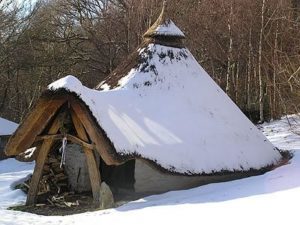
A neolithic hut, pinned from naturalhomes.com
His body, which was broad and tall and built for the hunt, felt suddenly awkward in the enclosed space. He looked around, stepped to one side, and pulled back the flap of a hanging pelt. That revealed a miniature anteroom of sorts. He ducked his head beneath a bowed and rotting rafter and ventured into that space. Another fur-draped divider hung at one side, under which fiery light flickered. He headed for it, found one edge of the fur draping, and parted it to step through.
~
It’s #PoseidonWeek so if you comment/share below, you’ll be entered into a raffle for Poseidon swag provided by Zazzle. You can also enter the contest all this week (through Thursday, September 1st) at my Facebook page.









